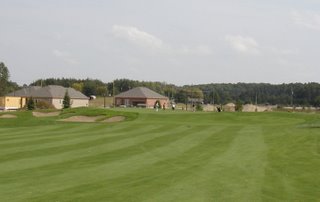The Three Schools of Design - and where I sit

Hell's half Acre - unquestionably penal (but great)
I was asked once my opinion on heroic, strategic and penal schools of architecture.
The penal school of design revolves around punishing a golfer for a missed shot. Whether a hook, a slice or a miss hit tee shot, they all end up penalized if the golfer does not find the target. Pine Valley, the greatest course in the world, is primarily penal in design. Their strength is that they reward accuracy above all else and that courses like are ideal for championship golf, but they unfortunately punish the average player so severely that they make the game too difficult for the average player. This would be the first school of design since the earliest changes by man seemed to follow this philosophy.
The 9th at Riviera, one of the most strategic courses in the World.
As the first architects appeared, their study of architecture brought new ideas about of golf design, and the strategic school grew as a reaction to the penal school of design. They felt that the penal architecture was too hard on the “dub” and that the game should challenge the great player without discouraging the poor player. The new architects started to look at positional play and rewarding a player for making a tough shot. If they provided a risky line from the tee, they would then reward the player with an easier approach to the green. They began to place hazards along the best route to defend holes while leaving the rest of the hole undefended for playability. The work of Tillinghast, Colt, Thomas and Mackenzie would be described as primarily strategic in nature.
The 16th at Cypress Point, certainly heroic, thank Merion Hollins for the hole.
The final style is well identified with Robert Trent Jones, but has origins with Charles Blair MacDonald and Stanley Thompson to name two other earlier architects. The final school was the heroic, where golfers are given either forced carries or very dangerous diagonal carries over hazards. The island green at the TPC at Sawgrass could be called the ultimate heroic hole, but the 18th is likely the best example of the course. Golfers are invited to dare as much as they can for ideal position, but the penalty is a return to the tee for missing the shot. As you can see this is actually a blending of penal and strategic into a new school. The work of Pete Dye has evolved into heroic through his evolutions.
So where do I stand on this? Penal all by itself will discourage all but the greatest players and even then would be fairly daunting as a daily diet. Heroic is fun on occasion, but there are far too many course where the player faces one carry after another to the point where they can’t distinguish one course from another or even one hole from another on the same course. This strategy is so overused by modern architecture that it is dull through repetition. So that leaves me as a strategic designer right?
Sort of, but I believe the only way to design is to let the land dictate the holes and the strategy. That means there should be no set style. If a natural heroic carry appears, or a hole is surrounded by trouble (that would be penal) then that becomes part of the course. I’m mostly sitting in the strategic school of design because I definitely like to defend the ideal line to a hole and I strongly believe in some playability, but limiting myself to one school of design would limit the creativity and the variety of my golf courses. I do know I believe in a little more penal and a lot less heroic architecture than the modern designers, but generally yes I would sit in the school of the strategic.
One footnote to this is that I very strongly believe in penal hazards (bunkers), which is different from penal design. There is no question in my mind that a great hazard like the Road Hole Bunker can make for fascinating holes while providing lots of room for the weaker player to avoid them. Whether that is strategic, penal or heroic architecture, it is still great architecture and that matters more that a label.










